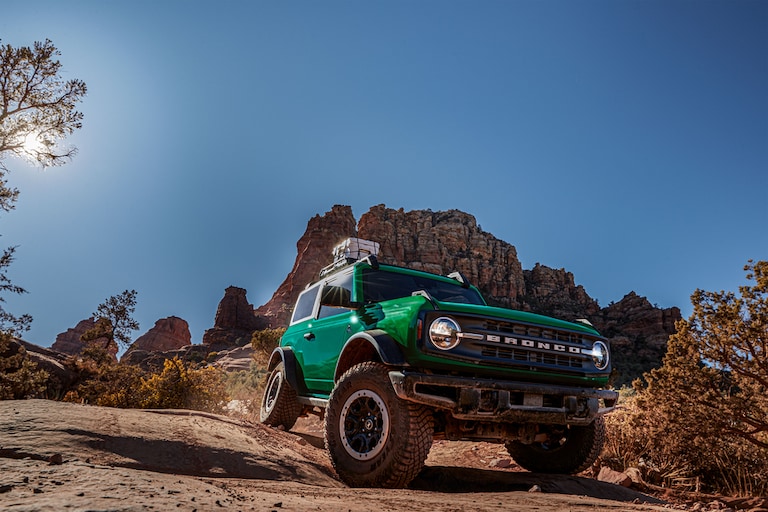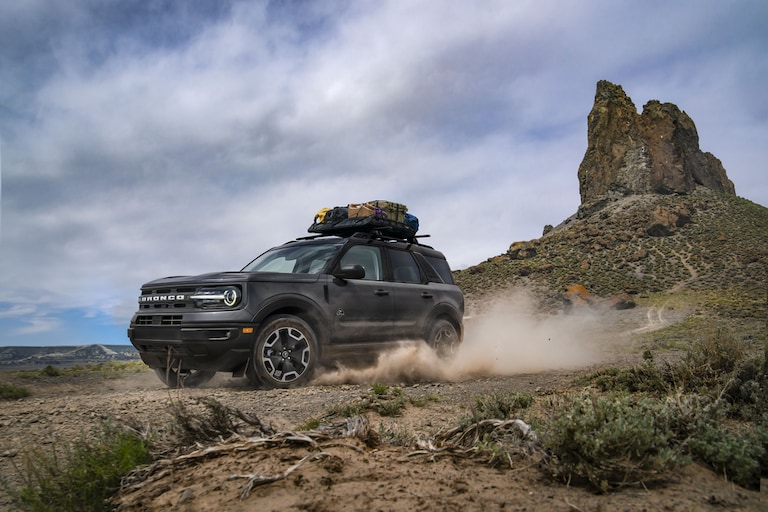
Ford Bronco vs Bronco Sport
Ford Bronco vs. Ford Bronco Sport: Which Adventure-Ready Ford SUV is Right for You?
Since its triumphant return for the 2021 model year, the Ford Bronco has established itself as the industry's standard-setting 4x4. The newest generation of the legendary trail-tackler sports a nostalgic retro-inspired design and offers comfortable accommodations, plentiful utility, and a peerless off-road pedigree. The Ford Bronco is so good at what it does that it earned two consecutive inclusions on Car and Driver's 10Best list (2022, 2023). But what if you like the Bronco's styling and adventurous character but need a daily driver that's more affordable and maneuverable?
While the Ford Bronco midsize SUV is the clear choice for anyone seeking to maximize their off-road prospects, its smaller sibling, the Bronco Sport, offers impressive capability worthy of its equine moniker. To help you determine which one best fits your needs and lifestyle, here's a look at some important distinguishing attributes.
Ford Bronco vs. Ford Bronco Sport: Size
Bronco Sport
- L x W x H (inches): 172.7 x 74.3 x 70.2
- Seating: 5
- Headroom front/rear (inches): 41.4 / 41.7
- Legroom front/rear (inches): 42.4 / 36.9
- Cargo capacity behind rear seats (cubic feet): 32.5
Situated between the subcompact and compact crossover segments, the Bronco Sport's shorter length and slimmer width are ideal for Trenton-area drivers who want excellent versatility while retaining city-friendly space requirements. It's also more comfortable and maneuverable for on-road driving thanks to its car-based unibody platform. While smaller on the outside, the Bronco Sport makes great use of its interior dimensions, offering one of the segment's roomiest cabins. Folding the rear seats expands the cargo area to 65.2 cubic feet.
Bronco (4dr)
- L x W x H (inches): 189.4 x 75.9 x 73
- Seating: 5
- Headroom front/rear (inches): 43.3 / 41.1
- Legroom front/rear (inches): 43.1 / 36.3
- Cargo capacity behind rear seats (cubic feet): 38.3
The four-door Ford Bronco is nearly a foot and a half longer than the Bronco Sport, leveraging its larger dimensions for even roomier passenger accommodations and a capacious cargo area that expands to 83 cubic feet with the rear seats folded. The Bronco isn't as nimble as its smaller sibling. And wider, knobbier tires and a removable roof make it a little louder on the highway. However, when it comes to adventures beyond the asphalt, the Bronco is in another league.
Powertrain Options
Bronco Sport
Most Ford Bronco Sport trims are equipped with a 1.5-liter EcoBoost® turbo-three that sends 181 horsepower and 190 pound-feet of torque to the 4WD system via an eight-speed automatic transmission. If you want a more potent crossover to power your Princeton commute, the top-tier Badlands trim upgrades to a 2.0-liter EcoBoost® turbo-four (250 hp, 277 lb-ft) and advanced 4WD with a Twin-Clutch Rear Drive Unit.
Bronco (4dr)
The Ford Bronco's standard powerplant is a 2.3-liter EcoBoost® turbo-four with 300 horsepower and 325 pound-feet of torque. A class-exclusive seven-speed manual transmission handles the gear changes, or you can opt for a 10-speed automatic. The Bronco's standard drivetrain is an Electronic Shift-on-the-Fly part-time 4x4 system with a 2-speed transfer case.
While the base engine has ample internal motivation for off-road exploration, if you want something even more capable, the Ford Bronco has you covered. Standard for Wildtrak and optional for other trims, the 2.7-liter twin-turbo V-6 generates a commanding 330 horsepower and 415 pound-feet of torque.
Capability
Bronco Sport
Regarding "serious" off-roading, it must be said that the purpose-built, truck-based Bronco SUV is this matchup's clear winner and the only one capable of taking on the most challenging and technical trails. That said, even with its unibody crossover platform, the Bronco Sport is more capable than you might think thanks to standard 4WD and a Terrain Management System™ with at least five G.O.A.T Modes (Go Over All types of Terrain).
The Bronco Sports off-road prospects are most realized in the Badlands trim. In addition to a more powerful engine and an advanced 4x4 system, the Bronco Sport Badlands is equipped with off-road-tuned suspension, Pirelli (or optional Falken Wildpeak) all-terrain tires, bash plates, tow hooks, a 180-degree front trail camera, a special off-road cruise control feature (Ford Trail Control), and two additional G.O.A.T. modes (Mud/Ruts, Rock Crawl). It's more than up to the task of traversing bumpy, gravelly, and undulating topography to your remote campsite, but it should avoid obstacles like rock gardens and deep sand.
Bronco
While the Bronco Sport can venture where most in its class can't, its larger Bronco brother is in a league of its own. Purpose-built for out-of-bounds adventures, the Ford Bronco offers a comprehensive array of terrain-conquering attributes, including robust powerplant options, off-road-tuned transmissions and drivetrains, and equipment like:
- High-speed Off-road Suspension Systems (H.O.S.S.) 1.0, 2.0, and 3.0
- Fox shocks with internal bypass dampers
- Electronic Front-and Rear-Locking Differentials
- Dana™ AdvanTEK® M210 front and M220 rear axles with electronic lockers
- Front stabilizer bar disconnect
- Up to 8 G.O.A.T. modes
- Heavy-duty bumpers and bash plates
- Removable roof and doors
- Available Trail Turn Assist, Ford Trail Control, and Trail 1-Pedal Drive

Features and Tech
The Bronco and Bronco Sport off impressively equipped trim levels. However, there are several significant differences to consider./p>
- The Bronco Sport comes standard with Ford Co-Pilot360™, a suite of advanced safety technologies that includes collision mitigation, blind-spot monitoring, cross-traffic alert, lane keeping, and automatic high beams. The Bronco SUV makes these technologies optional since many off-road enthusiasts prioritize a more accessible price tag over on-road-focused features. While both models scored top marks in IIHS crash evaluations, the Bronco Sport's standard safety features helped it earn a Top Safety Pick+ rating.
- The Bronco Sport has an 8-inch SYNC 3 touchscreen infotainment system with Apple CarPlay and Android Auto, while a 6.5-inch LCD Instrument Panel is standard in Outer Banks and higher trims. The Ford Bronco includes an 8-inch digital gauge cluster and Ford's next-gen SYNC 4 system with wireless smartphone integration on all trims. An optional High Package upgrades the 8-inch touchscreen to a larger 12-inch display.
- All-terrain tires are standard across the Ford Bronco lineup, except the base trim, which has standard all-season rubber. For the Bronco Sport, only the Badlands trim comes standard with all-terrain tires.
- While a 180-degree front trail camera is available for both models, the Ford Bronco SUV also offers a 360-degree surround-view system.
- Because the Bronco Sport is primarily focused on being a great all-around daily driver, its levels are more linear and amenity-focused. Many features that are standard in a given Bronco Sport trim are bundled in packages for the Bronco. Examples include dual-zone automatic climate control, heated seats, remote start, proximity entry, ambient lighting, and more.
Test-Drive the Ford Bronco and Bronco Sport near Ewing and Plainsboro
For more information about these two excellent utility vehicles and their available configurations, financing offers, or reservation opportunities, get in touch with Ciocca Ford of Lawrenceville at your convenience. If you'd like to compare the accommodations, amenities, and performance of the Bronco and Bronco Sport firsthand, we invite you to schedule a test drive or visit our Lawrenceville dealership. We'll be happy to show you around.


